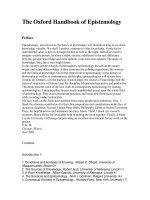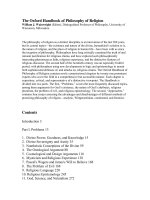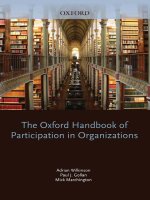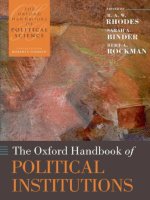- Trang chủ >>
- Khoa Học Tự Nhiên >>
- Vật lý
the oxford handbook of political institutions nov 2006
Bạn đang xem bản rút gọn của tài liệu. Xem và tải ngay bản đầy đủ của tài liệu tại đây (3.41 MB, 835 trang )
the oxford handbook of
POLITICAL
INSTITUTIONS
Edited by
R. A. W. RHODES
SARAH A. BINDER
and
BERT A. ROCKMAN
1
the oxford handbook of
POLITICAL
INSTITUTIONS
the
oxford
handbooks
of
political
science
General Editor: Robert E. Goodin
The Oxford Handbooks of Political Science is a ten volume set of reference books
oVering authoritative and engaging critical overviews of all the main branches of
political science.
The series as a whole is under the General Editorship of Robert E. Goodin, with
each volume being edited by a distinguished international group of specialists in their
respective Welds:
POLITICAL THEORY
John S. Dryzek, Bonnie Honig & Anne Phillips
POLITICAL INSTITUTIONS
R. A. W. Rhodes, Sarah A. Binder & Bert A. Rockman
POLITICAL BEHAVIOR
Russell J. Dalton & Hans Dieter Klingemann
COMPARATIVE POLITICS
Carles Boix & Susan C. Stokes
LAW & POLITICS
Keith E. Whittington, R. Daniel Kelemen & Gregory A. Caldeira
PUBLIC POLICY
Michael Moran, Martin Rein & Robert E. Goodin
POLITICAL ECONOMY
Barry R. Weingast & Donald A. Wittman
INTERNATIONAL RELATIONS
Christian Reus Smit & Duncan Snidal
CONTEXTUAL POLITICAL ANALYSIS
Robert E. Goodin & Charles Tilly
POLITICAL METHODOLOGY
Janet M. Box Steffensmeier, Henry E. Brady & David Collier
This series aspires to shape the discipline, not just to report on it. Like the Goodin
Klingemann New Handbook of Political Science upon which the series builds, each of
these volumes will combine critical commentaries on where the Weld has been
together with positive suggestions as to where it ought to be heading.
3
Great Clarendon Street, Oxford ox2 6dp
Oxford University Press is a department of the University of Oxford.
It furthers the University’s objective of excellence in research, scholarship,
and education by publishing worldwide in
Oxford New York
Auckland Cape Town Dar es Salaam Hong Kong Karachi
Kuala Lumpur Madrid Melbourne Mexico City Nairobi
New Delhi Shanghai Taipei Toronto
With oYces in
Argentina Austria Brazil Chile Czech Republic France Greece
Guatemala Hungary Italy Japan Poland Portugal Singapore
South Korea Switzerland Thailand Turkey Ukraine Vietnam
Oxford is a registered trade mark of Oxford University Press
in the UK and in certain other countries
Published in the United States
by Oxford University Press Inc., New York
ß the several contributors 2006
The moral rights of the authors have been asserted
Database right Oxford University Press (maker)
First published 2006
All rights reserved. No part of this publication may be reproduced,
stored in a retrieval system, or transmitted, in any form or by any means,
without the prior permission in writing of Oxford University Press,
or as expressly permitted by law, or under terms agreed with the appropriate
reprographics rights organization. Enquiries concerning reproduction
outside the scope of the above should be sent to the Rights Department,
Oxford University Press, at the address above
You must not circulate this book in any other binding or cover
and you must impose the same condition on any acquirer
British Library Cataloguing in Publication Data
Data available
Library of Congress Cataloging in Publication Data
Data available
Typeset by SPI Publisher Services, Pondicherry, India
Printed in Great Britain
on acid free paper by
Biddles Ltd., King’s Lynn, Norfolk
ISBN 0 19 927569 6 978 0 19 927569 4
13579108642
Contents
About the Contributors ix
Preface xii
PART I INTRODUCTION
1. Elaborating the ‘‘New Institutionalism’’ 3
James G. March & Johan P. Olsen
PART II APPROACHES
2. Rational Choice Institutionalism 23
Kenneth A. Shepsle
3. Historical Institutionalism 39
Elizabeth Sanders
4. Constructivist Institutionalism 56
Colin Hay
5. Network Institutiona lism 75
Christopher Ansell
6. Old Institutionalisms 90
R. A. W. Rhodes
PART III INSTITUTIONS
7. The State and State-building 111
Bob Jessop
8. Development of Civil Society 131
Jose Harris
9. Economic Institutions 144
Michael Moran
10. Exclusion, Inclusion, and Political Institutions 163
Matthew Holden, jr.
11. Analyzing Constitutions 191
Peter M. Shane
12. Comparative Constitutions 217
Josep M. Colomer
13. American Federalism and Intergovernmental Relations 239
Alberta M. Sbragia
14. Comparative Federalism 261
Brian Galligan
15. Territorial Institutions 281
Jean-Claude Thoenig
16. Executives—The American Presidency 303
William G. Howell
17. Executives in Parliamentary Government 323
R. A. W. Rhodes
18. Comparative Executive–Legislative Relations 344
Matthew Søberg Shugart
19. Public Bureaucracies 366
Donald F. Kettl
20. The Welfare State 385
Jacob S
. Hacker
21. The Regulatory State? 407
John Braithwaite
22. Legislative Organization 431
John M. Carey
23. Comparative Legislative Behavior 455
Eric M. Uslaner & Thomas Zittel
24. Bicameralism 474
John Uhr
25. Comparative Local Governance 495
Gerry Stoker
vi contents
26. Judicial Institutions 514
James L. Gibson
27. The Judicial Process and Public Policy 535
Kevin T. McGuire
28. Political Par ties In and Out of Legislatures 555
John H. Aldrich
29. Electoral Systems 577
Shaun Bowler
30. Direct Democracy 595
Ian Budge
31. International Political Institutions 611
Richard Higgott
32. International Security Institutions: Rules, Tools, Schools,
or Fools? 633
John S. Duffield
33. International Economic Institutions 654
Lisa L. Martin
34. International NGOs 673
Ann Florini
PART IV OLD AND NEW
35. Encounters with Modernity 693
Samuel H. Beer
36. About Institutions, Mainly, but not Exclusively, Political 716
Jean Blondel
37. Thinking Institutionally 731
Hugh Heclo
38. Political Institutions—Old and New 743
Klaus von Beyme
Index 759
contents vii
About the Contributors
John H. Aldrich is PWzer-Pratt University Professor in the Department of Political
Science, Duke University.
Christopher Ansell is Associate Professor, Department of Political Science in the
University of California, Berkeley.
Samuel H. Beer is Eaton Professor of the Science of Government emeritus, Harvard
University.
Sarah A. Binder is a Senior Fellow in Governance Studies at the Brookings
Institution and Professor of Political Science at George Washington University.
Jean Blondel is Professorial Fellow at the European University Institute, Florence,
and Visiting Professor, University of Siena.
Shaun Bowler is Professor and interim Chair in the Department of Political
Science, University of California, Riverside.
John Braithwaite is an Australian Research Council Federation Fellow in RegNet,
the Research School of Social Sciences, Australian National University.
Ian Budge is Professor in the Department of Government, University of Essex.
John M. Carey is Professor in the Department of Government, Dartmouth College.
Josep M. Colomer is Research Professor in Political Science in the Higher Council
of ScientiWc Research, Barcelona.
John S. DuYeld is Professor in the Department of Political Science, Georgia State
University.
Ann Florini is Senior Fellow, Foreign Policy Studies, The Brookings Institution.
Brian Galligan is Professor in the Department of Political Science, University of
Melbourne.
James L. Gibson is Sidney W. Souers Professor of Government at Washington
University in St. Louis.
Jacob S. Hacker is Peter Strauss Family Associate Professor of Political Science at
Yale University.
Jose Harris is Professor of Modern Histor y, University of Oxford.
Colin Hay is Professor of Political Analysis in the Department of Politics and
International Studies, University of Birmingham.
Hug h Heclo is Clarence J. Robinson Professor of Public AVairs, George Mason
University.
Richard Higgott is Professor of Politics and International Studies at the University
of Warwick.
Matthew Holden, Jr. is Emeritus Professor in the Department of Politics, University
of Virginia.
William G. Howell is an Associate Professor in the Harris School of Public Policy,
University of Chicago.
Bob Jessop is Director of the Institute for Advanced Studies and Professor of
Sociology at Lancaster University.
Donald F. Kettl is Director of the Fels Institute of Government and Stanley I. Sheer
Endowed Chair in the Social Sciences at University of Pennsylvania.
James G. March is Emeritus Professor in the Department of Political Science,
Stanford University.
Lisa L. Martin is Clarence Dillon Professor of International AVairs in the Govern-
ment Department at Harvard University.
Kevin T. McGuire is Associate Professor in the Department of Political Science,
University of North Carolina.
Michael Moran is W. J. M. Mackenzie Professor of Government in the School of
Social Sciences, University of Manchester.
Johan P. Olsen is Professor in the Centre for European Studies, University of Oslo.
R. A. W. Rhodes is Professor of Political Science and Head of Program in the
Research School of Social Sciences, Australian National University.
Bert A. Rockman is Professor of Political Science and Head of the Department at
Purdue University.
Elizabeth Sanders is Professor in the Department of Government, Cornell
University.
Alberta M. Sbragia is Jean Monnet Chair ad personam in the Department of
Political Science and the Director of the Center for West European Studies and of
the European Union Center of Excellence at the University of Pittsburgh.
x list of contributors
Peter M. Shane is Joseph S. Platt/Porter Wright Morris and Arthur Professor of Law
at Ohio State University.
Kenneth A. Shepsle is George D. Markham Professor of Government in the Social
Sciences at Harvard University.
Matthew Søberg Shugart is Professor of Political Science and at the Graduate
School of International Relations and PaciWc Studies, University of California,
San Diego.
Gerry Stoker is Professor in the Institute of Political and Economic Governance,
University of Manchester.
Jean-Claude Thoenig is Professor of Sociology at INSEAD, Fontainebleau, and
Directeur de recherche at Dauphine Recherche en Management (DMSP), Univer-
sity of Paris Dauphine.
John Uhr is Reader in Politics in the Asia PaciWc School of Economics and
Government, Australian National University.
Eric M. Uslaner is Professor in the Department of Government and Politics,
University of Maryland.
Klaus von Beyme is Professor InstitutsproWl, zentrale Einrichtungen, University of
Heidelberg.
Thomas Zittel is Project Director, European Political Systems and their Integration,
at the University of Mannheim.
list of contributors xi
Preface
The study of political institutions is central to the identity of the discipline of
political science. When political science emerged as a separate Weld, it emphasized
the study of formal-legal arrangements as its exclusive subject matter (Eckstein
1963, 10–11). For a time, institutions ‘‘receded from the position they held in the
earlier theories of political scientists’’ (March and Olsen 1984, 734). Recent decades
have seen a neoinstitutionalist revival in political science—a return to the roots of
political study. This Handbook begins in that most appropriate of places, an
institutionalist call to arms by March and Olsen themselves.
While the older study of institutions is often caricatured today as having been
largely descriptive and atheoretical, more nuanced accounts of the origins of the
professionalized study of politics recall the profession’s early focus on political
institutions as prescriptive based on comparative, historical, and philosophical
considerations (see especially Chapter 6). The older studies of institutions were
rooted in law and legal institutions, focusing not only on how ‘‘the rules’’ chan-
neled behavior, but also on how and why the rules came into being in the Wrst
place, and, above all, whether or not the rules worked on behalf of the common
good.
As political science foreswore its historical, legal, and philosophical foundations,
it borrowed deeply from economics, sociology, anthropology, and social and (later)
cognitive psychology—the currents of knowledge that formed the bases of the
‘‘behavioral revolution’’ (Dahl 1961). That revolution followed from empirical
observations in organizational and industrial sociology and psychology that
revealed discrepancies between behaviors and organization forms noted in the
1930s (Roethlisberger and Dickson 1939). People frequently did not adhere to the
rules, and informal groups of peers often became more inXuential than the formal
organizational settings these individuals found themselves in. Moreover, the advent
of the technology of mass surveys at mid-century allowed researchers to discover
how remote average citizens were from the normative role of involved rationality
toward and comprehension of the political environment (Campbell et al. 1960).
The institutions of constitutional government seemed to operate at some distance
from the cognitive limits of citizens.
The return of institutions to the mainstream of political studies arose, in part,
from comparative behavioral research suggesting that diVerences in behavior more
likely Xowed from variations in political organization than in essential variability
between citizenries of diVerent political systems (Converse and Pierce 1986). But
there also was a suspicion that less sophisticated versions of the behavioral revo-
lution had run their course—that ‘‘opinions’’ were free-Xoating and unhinged
from incentives to behave on them and that opinions were being treated as
increasingly endogenous, that is, individuals had either more or less structure to
their beliefs. What were the consequences, if any, of opinion? That question and the
need to understand the nature of continuity and change were fundamental to the
resurgence of institutions as a focus of analysis. Because institutions channeled the
opportunities and incentives for behavior or induced powerful insulation to
change, opinion distributions by themselves told us little.
Political scientists’ return to the study of institutions has been explored and
developed in many venues, most visibly perhaps by James March and Johan Olsen
(1984, 1989, 1995). As has become clear by the numerous essays examining the
institutional and historical turn of political science, no single orientation charac-
terizes the vast scholarship that falls under the heading of neoinstitutionalism
(see, among others, Hall and Taylor 1996; Pierson and Skocpol 2002). And as the
chapters in Part II of this volume attest, the range of theoretical approaches
underlying the contemporary study of institutions is remarkably diverse, let alone
the range of empirical and methodological orientations.
Despite the incredible growth in institutional studies in recent decades, we lack a
singular deWnition of an institution on which students of politics can Wnd wide
agreement. Indeed, if anything, we have witnessed an even greater diversity of ideas
over the period as to what constitutes an institution. This range of ideas is
consequential: it signals that there are also considerable diVerences of view about
why and how we should study institutions, about the impact of institutions, and
indeed about the extent to which institutions may be thought to be endogenous
(independent or autonomous) or inextricably exogenous (woven into traditions,
culture, norms, and preferences).
There is no doubt that institutions are said to do quite a lot. For example, they
may be thought to embed history and political thought and to reXect, therefore, a
set of traditions and practices, whether written or unwritten. Institutions thus can
be interpreted as reXecting habits and norms, more likely to be evolved than to be
created. But institutions also may be seen as architecture and as rules that deter-
mine oppor tunities and incentives for behavior, inclusion and exclusion of poten-
tial players, and structuring the relative ease or diYculty of inducing change, and
the mechanisms through which change may be facilitated or denied.
Rational-choice institutionalists think of institutions as a system of rules and
incentives. They remind us that this way of seeing institutions has traditions in
law, but also in political engineering. The founders of American political science
were themselves proponents of a science of political engineering to improve the
preface xiii
common good—or at least they so justiWed these eVorts in this way. Of course, the
founders of the political science profession in the USA were themselves greatly
aVected by the temper of their times (the emergence of middle-class Progressivism
as a political force) which emphasized the reform of political institutions as a way of
weeding out both corruption and partisanship from politics—with the aim of
reorganizing politics more in the form of administration. The institutional reform
motif of American political science in the early twentieth century reXected not only
the reform focus of its time but also the idiosyncrasies of its own political culture.
Political institutions were largely seen as endogenous: rules, design, structures. It was
plausible to imagine institutions in this particular way in a society that had devel-
oped a strong legalistic tradition based on written documents and that lacked a past
struggle between aristocracy and commerce or a powerful working class mobiliza-
tion. Thus, there was little history—or so it was perceived—to be embedded into
American governing institutions other than through its colonial experience.
DeWned as rules, design, and structures, institutions are a potential variable in
the political process. In this view, rules that deWne institutions or that alter
thresholds for participation in the institution are likely to be contested to the
immediate political advantage of some set of actors over another. Institutions in
this sense provide arenas for conXict, and eVorts to alter them stimulate conXict
inasmuch as they change the rules of the game in such a way as to alter the
allocation of advantages and disadvantages. From this vantage point rules are
never neutral, but are instead part of a struggle between challengers and holders
of power.
Still, a more prevalent view of institutions as rules—derived from economic
models of cooperation—suggests that institutions may be the product of agree-
ments that are Pareto optimal—that is, one party is made better oV, but no one is
made worse oV. Log rolls, reciprocities, mutual advantages also produce new
institutional arrangements. And there is a reciprocal relationship here; that is,
institutions of certain forms, particularly ones that fragment power and provide
multiple veto points, are likely to induce log rolling, reciprocities, and mutual back
scratching. Such conditions make coherent change or direction and central lead-
ership less likely, all things equal, though hardly impossible.
Inevitably, institutions advantage some in the short term and disadvantage
others, but the long run may be a diVerent story. The same rules and structures
may, over longer stretches of time, provide advantages or disadvantages to diVerent
interests, indeed even reversing which interests are advantaged or disadvantaged.
The so-called Wlibuster rule of the US Senate, ironically the product of an e Vort to
create greater institutional eYciencies by deterring tiny minorities from tying up
the Senate indeWnitely, clearly helps concerted and substantial minorities and
frustrates majorities that are less than supermajorities. It had been used by
conservatives to block liberals’ civil rights agendas. Now it is being used by liberals
to forestall the aims of conservatives. In this sense—what goes around comes
xiv preface
around—institutions that strengthen the blocking power of minorities may be
remarkably equitable, though perhaps only when viewed in historical, rather than
immediate, terms.
Historical institutionalists see institutions as continuities. As they point out,
institutions are meant to be preservative. Indeed, the emphasis on path dependence
is another way of saying that the transaction costs of doing things diVerently is
almost always prohibitively high, although dire conditions may reduce the mar-
ginal costs of change. But if institutions are about preservation, politics is about
manipulation and leadership is about overturning constraints. Consequently,
institutions are like dried cement. Cement can be uprooted when it has dried,
but the eV ort to do so is substantial. It is easier to alter the substance before it
hardens. Exiting leaders want to harden their preferences through institutions; new
leaders often want to extirpate the past. The consequence is that institutions may
be designed to fail. Given uncertainty about future political control, majorities may
prefer to hedge their bets (Tsebelis 1990) or even prefer to design ineVective
institutions than risk having their creations used against them (Moe 1990).
Institutions, of course, are constituted at many levels. They may be constitu-
tional; they may be procedural; and they may be programmatic—for example,
national health insurance or national pension systems. One should expect pro-
grams that have been durable and thus thought of as being institutionalized to be
more responsive to exogenous shocks than changes at the constitutional level. But
it is not always clear that this logic obtains in a general sense. Durable programs are
partly a reXection of the real Wnancial costs of altering them and the political costs
of changing popular programs. Changing the social security system wholesale by
privatizing it could be done in an authoritarian system under the Pinochet
government in Chile, but it has proven to be much more complicated in demo-
cratic systems. The cumulative weight of past choices—which help to shape actors’
preferences, routines, and expectations—plus the preferences of stable majorities
inhibit large-scale or relatively rapid change.
Clearly, in any conception of institutions, the cost of change whether formal or
non-formal and whether Wnancial or organizational must be part of what an
institution confers. Equally, the political costs of trying to disturb the status quo
are far greater where the struggle involves many actors with diverse preferences
rather than only a few with homogeneous preferences. So, any system that makes
decision-making diYcult tends toward the preservation of existing institutions.
But none of this is absolute.
Sociological institutionalism sees institutions as norms and culture. It points to
an alternative view, which suggests that institutions are almost wholly exogenous,
by which they mean that the history and norms of a polity become embedded into
institutions. We think of institutions in this perspective as exogenous, because it is
hard to consider them as creations of ambitious political actors. Instead,
preface xv
institutions are viewed as independent entities that over time shape a polit y by
inXuencing actors’ preferences, perceptions, and identities. Individuals are
governed, as March and Olsen (1989, 1995) would say, by the ‘‘logic of appropri-
ateness’’—meaning that institutions can be considered as embedding rules and
routines that deWne what constitutes appropriate action. Rather than acting out of
overt rational self-interest, individuals are said to behave according to their sense of
duty and obligation as structured by prevailing rules and routines. However, when
preferences are suYciently homogeneous, it may be in one’s self-interest to
get along rather than be seen as a deviant.
This view of institutions has implications for the character and pace of institu-
tional change. We might say that there is a superstability to institutions because
they are woven into an historical and normative fabric. In other words, there are no
obvious means of altering institutions, short of signiWcant social, cultural, or
political change. The important implication is that institutions evolve in a rather
indeterminate way, resembling if anything geological shifts and drift, rather than
conscious design. This geological view recalls the perspective of institutional
scholars of the early twentieth century, such as Edward Sait, who viewed institu-
tions as ‘‘coral reefs’’ that grew by ‘‘slow accretions’’ (Sait 1938). The historical
approach underlying this view of institutions as norms and culture should thus
come as no surprise.
This brief survey of the multiple conceptions of institutions provides an apt
launching point for this volume on political institutions. It may be that this
book raises more questions than it answers about the origins, evolution, and
impact of institutions on politics and policy alike. Our hunch is that such questions
and controversies will remain central to the agendas of political scientists for some
time to come. Where do institutions come from? How have they evolved and often
hardened over time? How diYcult or easy are the rules governing their change?
What are the consequences of institutions for political behavior and policy out-
comes? Can institutions resist exogenously induced pressures for change including
leaders’ eVorts to overturn the past? These questions are at the heart of the chapters
that follow—questions that we trust will continue to energize research on politics
in the years to come.
Starting with a statement from the founders of the ‘‘new institutionalism,’’ Part
II builds on various attempts (Hall 1996; Lowndes 1996; Peters 1999) to characterize
the diversity of institutional approaches. It surveys several theoretical approaches,
including normative institutionalism, rational choice institutionalism, historical
institutionalism, international institutionalism, constructed institutionalism, and
network institutionalism, as well as older traditions. Part III covers the traditional
concerns of political science with constitutions, federalism, executives, legislatures,
courts, parties, etc. These reXect the broadening concerns of the Weld in recent years
with chapters on international institutions and the institutions of state and civil
xvi preface
society. Furthermore, these reXect more recent interest in theory and the con-
structed nature of institutions. Finally, Part IV provides four reXections on ‘‘the
state of the art’’ by some of the master practitioners of the Weld.
In his Pense
´
es, Joseph Joubert (1842) advised, ‘‘One of the surest ways of killing a
tree is to lay bare its roots. It is the same with institutions. We must not be too
ready to disinter the origins of those we wish to preserve.’’ We disinter institutions,
not to kill them, but rather to learn from them as repositories of our collective
experience.
For any book on this scale, the editors need help. Rod Rhodes would like to
thank Bob Goodin and Mary Hapel. Sarah Binder would like to thank Alan
Murphy for research assistance. All the editors would like to thank the contributors
for their patience and cooperation when asked to revise their chapters.
References
Campbell, A., Converse, P. E., Miller, W. A., and Stokes,D.1960. The American Voter.
New York: Wiley.
Converse,P.E.andPierce,R.1986. Political Representation in France. Cambridge, Mass.:
Harvard University Press.
Dahl,R.A.1961. The behavioral approach in political science: epitaph for a monument to a
successful protest. American Political Science Review, 55: 763 72.
Eckstein,H.1963. A perspective on comparative politics: past and present. Pp. 3 32 in
Comparative Politics: A Reader, ed. H. Eckstein and D. E. Apter. Glencoe, Ill.: Free Press.
Hall, P. and Taylor,R.1996. Political science and the three institutionalisms. Political
Studies, 44: 936 57.
Joubert,J.1842/1928. Pense
´
es and Letters, trans. H. P. Collins. New York: Brenatno’s.
Lowndes,V.1996. Varieties of new institutionalism: a critical appraisal. Public Adminis
tration, 74: 181 97.
March, J. G. and Olsen,J.P.1984. The new institutionalism: organizational factors in
political life. American Political Science Review, 78: 734 49.
1989. R
ediscovering Institutions. New York: Free Press.
1995. Democratic Governance. New York: Free Press.
Moe,T.1990. Political institutions: the neglected side of the story. Journal of Law, Eco
nomics, and Organization, 6: 213 53.
Peters,B.G.1999. Institutional Theory in Political Science: The ‘‘New Institutionalism.’’
London: Pinter.
Pierson, P. and Skocpol,T.2002. Historical institutionalism in contemporary political
science. Pp. 693 721 in Political Science: State of the Discipline, ed. H. Milner and
I. Katznelson. New York: Norton.
Roethlisberger,F.J.andDickson,W.J.1939. Management and the Worker. Cambridge,
Mass.: Harvard University Press.
Sait,E.M.1938. Political Institutions: A Preface. New York: Appleton Century.
Tsebelis,G.1990. Nested Games. Berkeley: University of California Press.
preface xvii
part i
INTRODUCTION
chapter 1
ELABORATING THE
‘‘NEW
INSTITUTIONALISM’’
james g. march
johan p. olsen
1 An Institutional Perspective
An institution is a relatively enduring collection of rules and organized practices,
embedded in structures of meaning and resources that are relatively invariant in the
face of turnover of indiv iduals and relatively resilient to the idiosyncratic preferences
and expectations of individuals and changing external circumstances (March and
Olsen 1989, 1995). There are constitutive rules and practices prescribing appropriate
behavior for speciWc actors in speciWc situations. There are structures of meaning,
embedded in identities and belongings: common purposes and accounts that give
direction and meaning to behavior, and explain, justify, and legitimate behavioral
codes. There are structures of resources that create capabilities for acting. Institu-
tions empower and constrain actors diVerently and make them more or less capable
of acting according to prescriptive rules of appropriateness. Institutions are also
reinforced by third par ties in enforcing rules and sanctioning non-compliance.*
* We thank Robert E. Goodin for constructive comments.
While the concept of institution is central to much political analysis, there is
wide diversity within and across disciplines in what kinds of rules and relations are
construed as ‘‘institutions’’ (Goodin 1996, 20). Moreover, approaches to political
institutions diVer when it comes to how they understand (a) the nature of
institutions, as the organized setting within which modern political actors most
typically act; (b) the processes that translate structures and rules into political
impacts; and (c) the processes that translate human behavior into structures and
rules and establish, sustain, transform, or eliminate institutions.
Institutionalism, as that term is used here, connotes a general approach to the
study of political institutions, a set of theoretical ideas and hypotheses concerning
the relations between institutional characteristics and political agency, perform-
ance, and change. Institutionalism emphasizes the endogenous nature and social
construction of political institutions. Institutions are not simply equilibrium
contracts among self-seeking, calculating individual actors or arenas for contend-
ing social forces. They are collections of structures, rules, and standard operating
procedures that have a partly autonomous role in political life.
Institutionalism comes in many Xavors, but they are all perspectives for under-
standing and improving political systems. They supplement and compete with two
other broad interpretations of politics. The Wrst alternative is a rational actor
perspective which sees political life as organized by exchange among calculating,
self-interested actors. The second alternative is a cultural community perspective
which sees political life as organized by shared values and world-views in a
community of common culture, experience, and vision. The three perspectives—
institutional, rational actors, and cultural community—are not exclusive. Most
political systems can be interpreted as functioning through a mix of organizing
principles. Nor are the perspectives always easy to distinguish. True believers in any
one of the three can reduce each of the other two to the status of a ‘‘special case’’ of
their preferred alternative. Pragmatically, however, the three perspectives are diVer-
ent. They focus attention on diVerent aspects of political life, on diVerent explana-
tory factors, and on diVerent strategies for improving political systems.
The key distinctions are the extent to which a perspective views the rules and
identities deWned within political institutions as epiphenomena that mirror envir-
onmental circumstances or predetermined individual preferences and initial
resources; and the extent to which a perspective pictures rules and identities
as reproduced with some reliability that is, at least in part, independent of
environmental stability or change.
Within an institutional perspective, a core assumption is that institutions create
elements of order and predictability. They fashion, enable, and constrain political
actors as they act within a logic of appropriate action. Institutions are carriers of
identities and roles and they are markers of a polity’s character, history, and visions.
They provide bonds that tie citizens together in spite of the many things that divide
4jamesg.march&johanp.olsen
them. They also impact institutional change, and create elements of ‘‘historical
ineYciency’’.
Another core assumption is that the translation of structures into political action
and action into institutional continuity and change, are generated by comprehen-
sible and routine processes. These processes produce recurring modes of action and
organizational patterns. A challenge for students of institutions is to explain how
such processes are stabilized or destabilized, and which factors sustain or interrupt
ongoing processes.
To sketch an institutional approach, this chapter elaborates ideas presented over
twenty years ago in ‘‘The New Institutionalism: Organizational Factors in Political
Life’’ (MarchandOlsen1984).The intent of the article wastosuggestsometheoretical
ideas that might shed light on particular aspects of the role of institutions in
political life. The aspiration was not to present a full-blown theory of political
institutions, and no such theory is currently available. The ideas have been chal-
lenged and elaborated over the last twenty years,1 and we continue the elaboration,
without making an eVort to replace more comprehensive rev iews of the diVerent
institutionalisms, their comparative advantages, and the controversies in the Weld.2
2 Theorizing Political Institutions
The status of institutionalism in political science has changed dramatically over the
last Wfty years—from an invective to the claim that ‘‘we are all institutionalists
now’’ (Pierson and Skocpol 2002, 706). The behavioral revolution represented an
attack upon a tradition where government and politics were primarily understood
in formal-legal institutional terms. The focus on formal government institutions,
constitutional issues, and public law was seen as ‘‘unpalatably formalistic and old-
fashioned’’ (Drewry 1996, 191), and a standard complaint was that this approach
was ‘‘relatively insensitive to the nonpolitical determinants of political behavior
and hence to the nonpolitical bases of governmental institutions’’ (Macridis
1963, 47). The aspiration was to penetrate the formal surface of governmental
1 March and Olsen 1984, 1986, 1989, 1995, 1998, 2006. Some have categorized this approach as
‘‘normative’’ institutionalism (Lowndes 1996, 2002; Peters 1999; Thoenig 2003). ‘‘Normative’’ then
refers to a concern with norms and values as explanatory variables, and not to normative theory in the
sense of promoting particular norms (Lowndes 2002, 95).
2 Goodin 1996; Peters 1996, 1999; Rothstein 1996; Thelen 1999; Pierson and Skocpol 2002; Weingast
2002; Thoenig 2003.
elaborating the ‘‘ new institutionalism’’ 5
institutions and describe and explain how politics ‘‘really works’’ (Eulau and March
1969, 16).
Theorizing political institutions, Polsby, for example, made a distinction
between seeing a legislature as an ‘‘arena’’ and as ‘‘transformative.’’ The distinction
reXected variation in the signiWcance of the legislature; its independence from
outside inXuence and its capacity to mould and transform proposals from
whatever source into decisions. In an arena-legislature, external forces were
decisive; and one did not need to know anything about the internal characteristics
of the legislature in order to account for processes and outcomes. In a transforma-
tive-legislature, internal structural factors were decisive. Polsby also suggested
factors that made it more or less likely that a legislature would end up as an
arena, or as a transformative institution (Polsby 1975, 281, 291–2).
More generally, students of politics have observed a great diversity of organized
settings, collectivities, and social relationships within which political actors have
operated. In modern society the polity is a conWguration of many formally
organized institutions that deWne the context within which politics and governance
take place. Those conWgurations vary substantially; and although there are dissent-
ers from the proposition, most political scientists probably would grant that the
variation in institutions accounts for at least some of the observed variation in
political processes and outcomes. For several centuries, the most important setting
has been the territorial state; and political science has attended to concrete political
institutions, such as the legislature, executive, bureaucracy, judiciary, and the
electoral system.
Our 1984 article invited a reappraisal of how political institutions could be
conceptualized, to what degree they have independent and endurable implications,
the kinds of political phenomena they impact, and how institutions emerge, are
maintained, and change:
First, we argued for the relative autonomy and independent eVects of political institutions
and for the importance of their organizational properties. We argued against understanding
politics solely as reXections of society (contextualism) or as the macro aggregate
consequences of individual actors (reductionism).
Second, we claimed that politics was organized around the interpretation of life and the
development of meaning, purpose, and direction, and not only around policy making and
the allocation of resources (instrumentalism).
Third, we took an interest in the waysinwhich institutionalized rules, norms, and standard
operating procedures impacted political behavior, and argued against seeing political action
solely as the result of calculation and self interested behavior (utilitarianism).
Fourth, we held that history is ‘‘ineYcient’’ and criticized standard equilibrium models
assuming that institutions reach a unique form conditional on current circumstances and
thus independent of their historical path (functionalism).
In this view, a political order is created by a collection of institutions that Wt more
or less into a coherent system. The size of the sector of institutionalized activity
6jamesg.march&johanp.olsen









